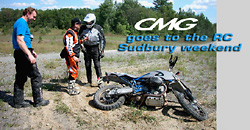|
|
|||||||||
LOST WEEKEND IN SUDBURY (OR THEREABOUTS)
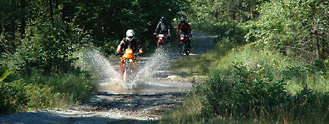 |
|
Getting in a groove. Photo: Dennis Kavish |
The thing was kicking. Kicking as in riding perfectly. I’d bonded fully with BMW’s HP2 as we skipped over the rocks and sandy ruts that dominate the trails around Sudbury in near-north Ontario.
I was fixated on the narrow trail ahead, analyzing each rock, rut and root ahead to see whether I could safely bounce over them or would have to twitch around them to avoid sending Beemer and rider into the surrounding brush. It became a video game as each obstacle is assessed for potential danger and suitable action decided upon, before looking for the next.
My fixation on the trail had meant that I’d not been able to do the occasional rearward glance to see if my riding colleagues were still in tow. So I broke the spell, pulled over and waited. And waited. Oh dear.
Okay, that’s been about a minute. Something’s up.
 |
|
Mr. Vidler didn't see the funny side ... Photo: Jim Vernon |
This is where dual-sporting is the same as road-sporting. The moment when you realize that your buddies are taking too long to catch up.
I gave them another 30 seconds then spun the HP2 around and retraced my route. Three minutes later I found them – two standing, one sitting, and one not-so-straight-looking KLR 650.
Oh dear, Mr. Vidler, you’re not looking very chipper.
This particular weekend that didn’t end so well for Mr. Vidler, was dual-sport event organizers, Rally Connex’s Nickel Belt Adventure Ride. It’s the second of the year (there are usually three to four in total), held just east of Sudbury. It’s the most remote of all the rides, and it’s also the most interesting.
But CMG hadn’t gone all the way to Sudbury for a mere joy-ride in the dirt. No, we wanted to learn how to ride this stuff better, and what better way to do that than a day’s school with US rally guru Scot Harden – an annual event tacked onto the beginning of the Nickel Belt weekend.
If only Mr. Vidler had attended the school part, things might have ended differently …
THE SCOT HARDEN SCHOOL
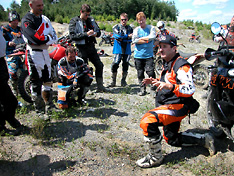 |
|
Scot Harden re-enacts his broken ankle experience. Dave Grummet (far left) tries to lighten the mood with his world famous Napoleon impression. |
Scot Harden’s done it all – the Baja 500 and 1000s, the ISDE and the granddaddy of all rallies – the Dakar. In fact he didn’t attempt the Dakar until 2004, when at the ripe age of 48 he suddenly found himself unexpectedly part of the Team KTM when one of their riders broke his leg in the final testing stages in Tunisia.
Although not exactly the way he had hoped to be able to fulfill his dream of riding the Dakar, as team manager and proven rallyist he was the most logical choice to fill in. But in typical Dakar style, the fairy tale didn’t quite go as planned when he crashed and broke his ankle near the end of the rally.
Undeterred, Harden was in the team again the following year, this time managing to finish the Dakar unscathed.
BACK TO CLASS
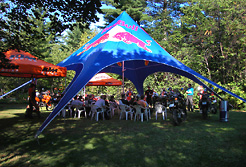 |
| Not your typical classroom. |
A morning ‘classroom’ session (about 1 1/2 hours) followed up by about 5 hours of practical constitutes the Dakar Rally Experience and is essentially a sample of Scot Harden’s more intensive 1,2 or 3 day schools in California and Virginia.
The classroom is actually a large Red Bull tent, erected on the grounds of the lodge where the event was being hosted. Here Harden goes over fundamental techniques, riding position and bike set-up.
There’s a lot you can learn from a guy like Harden and I found one of the most interesting bits of the classroom session to be about hydration. Basically drink a lot on a regular basis (about one litre every hour), but if you’re feeling thirsty then you’re already dehydrated.
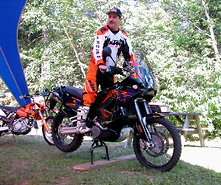 |
| He's a stand-up guy. |
Getting dehydrated is no trivial matter as it will cause your mind to wander and this will inevitably lead to a bad decision and very likely a crash. Ideally you want water with some kind of electrolyte replacement in it. Gatorade is not a good option as it’s too high in sugars. If you must, then dilute it to 10% of what they recommend, although that’s going to make a pretty dire tasting drink.
Harden is also a big proponent of standing up on the bike at all times, citing greater control of the motorcycle, better visibility and less fatigue (which I still find a bit odd). He also recommends that if you’re over 6 feet tall, then get some handlebar risers.
I can personally attest to this, although the problem with riding test bikes like the HP2 is that they come stock and sans risers. This also means that I may have given the impression that I was an arrogant journalist and was disregarding all I had just been told on the ride to the afternoon’s practical session after the classroom session. But there was no way I could stand for long on the HP2, thanks mainly to the low bars, but dickey knees weren’t helping either.
TO THE SAND PIT
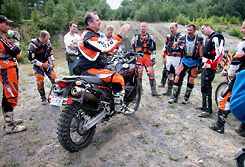 |
| Classroom # 2. |
The practical part of the course was an old sand pit about 80 km from the lodge. Being a Rally Connex event, this was reached through some pretty gnarly trails, the most challenging part being an old railway bed. Challenging? Well, the gravel would suck your wheels in and the dust cloud generated by the riders ahead, meant that you couldn’t really see anything until you were on it. Still, I guess it’s all part of the school (lesson two, scare yourself silly riding blind in a huge dust cloud)!
Once at the pit, we started with a drill called the ‘paper clip’. This involves placing two markers about 100m apart and then riding your bike like hell between the two. Well, sort of. What you actually had to do was accelerate to one marker (standing up of course), scrub off speed with the front brake, sit down, release the front brake, hit the turn of the second marker on the rear brake (while leaning over the front wheel), and then accelerate out of the corner in a glorious roost … oh, and stand up again in the process.
 |
| 'Arris stalls out once again. |
After three or four runs of this, you get a rut developing in the shape of a paper clip – thus the name. You also get very tired very quickly (well I do) and there’s also a lot of information to get your head around. Ironically, I seemed to get the complicated bit of going into the corner – it was the accelerating out that I seemed to mess up all the time. With a powerful bike like the HP2, that should have been the easy part, but then I’ve never really followed the rules of logic and so I saw no reason to start.
After-lunch entertainment started with a game of ‘Australian Pursuit’. This is essentially the paper clip again, but this time with two riders on it, starting at opposite ends, with the winner being the one who passes the other first.
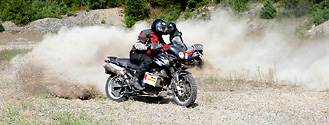 |
| Frank did stuff with a Tiger that you wouldn't have thought possible. Unfortunately this didn't help him in the Australian Pursuit. |
Jim Vernon stepped up to the plate on behalf of CMG and did us right proud when he managed to wheelie his KLR out of the first corner – carrying it all the way into a back flip. Needless to say the game was over in record breaking time and the CMG reputation reinforced.
Oddly, when I was expecting some more instruction to occur afterwards, instead we were let loose to ride around the sand pit. Granted, we were all probably a tad tired by then (at least that’s the excuse I’ll use for dumping the HP2 half way up the first hill climb), but it did feel like we had just called class early.
REPORT CARD
 |
| Bugger ... |
I have to admit, at the end of the day when we all sat down and discussed what we had learned there was general dissatisfaction. Where we’d expected several lessons at the sand pit, there had only been the one. There were also a lot of students for a single instructor (although Scot was helped by the Rally-Connex staff), which resulted in a slightly chaotic feel.
However, these opinions were formed on the Friday night. Fast forward to the Saturday night after a day of riding the trails and the opinions were polar opposites.
Mr. Seck was almost euphoric about how he had somehow managed to put it all together and had the ride of his life. Ed, who is relatively new to the world of dual-sporting and was close to giving it all up at the end of Friday, was likewise euphoric at the way his riding had suddenly gelled. Even Jim acknowledged that he’d been able to put all the little bits of theory together in the actual ride … although his wheelies could still do with a bit of work.
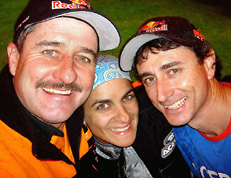 |
|
Scot with Rally-Connex's Najua and Predi Medina. Photo: Dennis Kavish |
For myself, I can’t claim euphoria, but I do recognize that any input from anyone of such experience and stature as Scot Harden is priceless in my quest to be as good a dirt rider as I can be. He certainly gave me food for thought on where I could apply some better theory to my riding...middle-age knees allowing.
MORE INFO
The Dakar Rally Experience is held once a year at the Rally Connex Nickel Belt Ride. Cost is $150.00, but you’ll also have to cover accommodation, food and fuel.
If you want a more intensive Harden experience, then you can attend one of his schools located in California and Virginia. Although these are somewhat pricier options, they do have a limit of eight riders and so include significantly more one-on-one training. Cost is US$350 to US$1295.00 depending on number of days and includes food and accommodation.
More info at www.harden-offroad.com and www.rallyconnex.com.
SECOND VIEWS
Since I was there with some other CMG regulars, it would only seem sensible to get their thoughts on the Dakar Rally Experience and the Rally Connex weekend. Following are reports from Mr. Seck (competent if a little ungraceful dirt rider) and Ed White (relatively new to this whole world having bought a BMW F650 last year).
RICHARD SECK
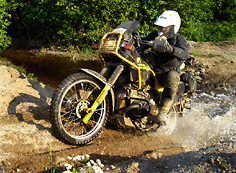 |
|
All part of the fun? Photo: Rob Harris |
Up until this year’s Scot Harden school, words like smooth and graceful could never be attributed to my off road technique. Having spent many years on dirt bikes in my youth (without any proper training), sure, I could keep a decent pace on the trails and gravel roads, and I simply thought the bike having a mind of its own underneath you was all part of the fun…
There was a certain magic to this weekend, as Scot created an environment that got everyone thinking and talking about how to ride better. Techniques learned during the school were then practiced on the following day’s ride.
I spent the morning working on my technique and by lunch I was smoothly carving the gravel roads and trails with ease. What a revelation! After lunch I ended up assuming the role of group leader (keep it down in the peanut gallery) and to ensure everyone had an entertaining ride I wicked up the pace on the Bumblebee and savoured the lack of dust at the front of the pack. What fun!
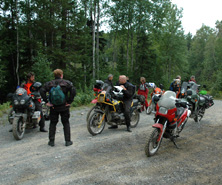 |
|
Mr. Seck receives adoration ... Photo: Dennis Kavish |
Although I didn’t expect to be leading such a large group of riders through this wilderness, I found myself quite enjoying it, and everyone in the group seemed to be having a great time as well. If that wasn’t enough, during the ride, Frank, who just came back from riding to Alaska, and can do things with a Triumph Tiger that you wouldn’t think possible, confided in me that sometimes these group stock tire rides can get a bit boring (for him) – but today, he was having fun! Coming from such an amazing rider, I took that as a huge compliment.
At dinner that night, I had a steady stream of riders coming over to the CMG table to thank me for leading such a great ride and compliment me on my riding technique. It got to the point where Editor ‘arris thought I was paying these fine gentlemen for the compliments!
Have fun,
Mr. Seck
ED WHITE
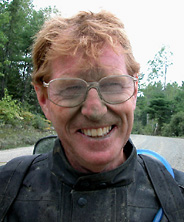 |
| There's a happy man. |
Although I own a dual sport I was never really able to grasp the attraction of gravel roads. It seemed that I was restricted to full bore down the straight followed by a tame walk around the corners. Not any longer!
Although Rally Connex firmly believes in throwing everyone into the deep end, where I thought I was surely going to meet my end on gnarly trails, shin deep gravel railway beds, and 120 foot high trestled railway bridges, I somehow survived the weekend and managed to learn what it was all about.
Constantly standing on the pegs, controlling the bike with my feet and knees, counter weighting on the outside peg – I have become “master of my domain"! I soon began to relish the opportunity to carve up the oncoming corners.
I found the instruction to be a form of osmosis, rather than a strict teaching atmosphere. You somehow found yourself internalizing the techniques imparted to you through informal discussions with other riders, leaders, and the affable Scot Harden.
The collegial atmosphere of all attendees coupled with a desire on the part of all to assist allows an inquisitive and questioning newbie ample opportunity to improve their riding technique and control.
All in all a great experience, but definitely not for the faint at heart.
Ed White
ABOUT RALLY CONNEX
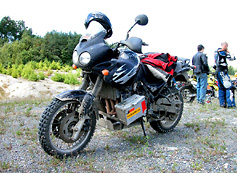 |
| Sadly, you won't be able to do this with the 2007 Tiger. |
There are many aspects to this sport of motorcycling, each one with its own benefits and attracting a particular type of motorcyclist. When I was a lad, it was all about going as fast as I could - and doing whatever I could to the bike to this end.
Once I started to mature (sad to say, not until my mid thirties, and even then some people might still disagree), things began to change. Pure speed started to get a bit scary. I needed something more than just being able to go fast. I needed something that still gave me the option of that thrill but included more … finesse.
This is when I discovered the world of dual-sporting. Soon after I also discovered Rally-Connex and their excellent dual-sport Adventure Ride Series and have been a devoted participant ever since.
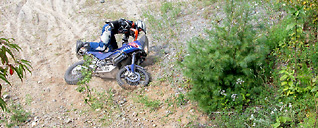 |
| Dual-sport tumbles are usually of the "oh bugger" nature ... |
Rally Connex runs between three and four events a year in various locations across Ontario. In 2006 there were three: The Blue Mountain (near Barrie), The Nickel Belt (near Sudbury) and the Opeongo Mountains (out of Cloyne – about an hour or so north of Napanee). Cost is $65.00 for a day or $130.00 for a two-day event.
There’s a choice of two routes – aggressive and standard. Aggressive is designed for 400cc to 650cc dual sport bikes, fitted with DOT knobby tires, whereas the standard route is for the less aggressive tires and bigger machines like the BMW GSs and KTM Adventures. Note, all bikes must be plated and insured for the road. It’s also a good idea to have a decent bash plate and bark busters attached – especially if you’re doing the aggressive route. Oh and make sure that the bike is set-up for you before the ride. You'll feel the aches and pains for days after if you don't!
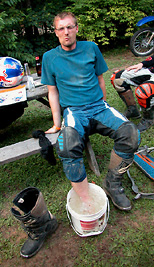 |
| ... although some times with a bit of pain too (particularly after a botched wheelie. |
Routes are provided for on GPS and are loaded onto your GPS when you arrive. If you don’t have a GPS, Rally-Connex will rent you one for $40.00 for the duration of the event. If you have other people to ride with, then one GPS for every two people should be fine.
Don’t try and do this without some basic rider protection including a chest guard, some elbow and knee protection and a good pair of steel-shanked boots. I tend to use my armoured road-gear, although it can be a bit of a pain to clean up afterwards. Either way, good protection makes all the difference between dusting yourself off and getting on with the ride versus waiting for the sweep truck to show up and take you to the local hospital … which might not be quite that local …
You’ll also need to take some trail snacks and a water supply (camelbacks are ideal). Oh, and some basic tools and tire repair stuff. A puncture is the most common of mishaps, so a spare front and back tube and some kind of inflation device is recommended. Did I mention a first aid kit? Basic bandage and ointments for grazes is always good.
BTW, if this is putting you off, then consider the standard route option. Here everyone tends to ride as a group, the trails are much easier, the pace slower and help is readily on hand.
More info at www.rallyconnex.com.
THANKS TO:
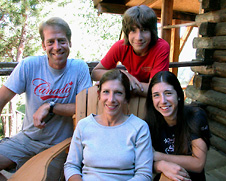 |
| The Robbins family were great! |
Rally Connex – for keeping the faith and doing such events despite all the work and the small return (you should also start an internet-based motorcycle magazine you know).
Scot Harden – for letting the CMG journalists partake in his Dakar Rally Experience.
Dennis Kavish – for the use of his photos.
The Sportsman’s Lodge in Garson – Run by owners Jody and George Robbins, the lodge is not only in a great location (lake front), it’s very lodge-like (timber-framed buildings) and the hosts are superb. Home cooked food is great (they even catered for veggie ‘arris) and there’s a bar and gas for your bike on premises. What more do you need?
More info at www.sportsmanslodge.net
![]()
